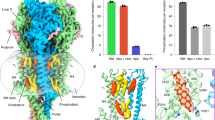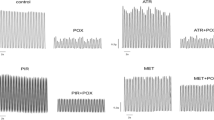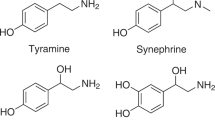Abstract
D-TUBOCURARINE is one of the most widely used drugs in pharmacology, physiology and anaesthesia. It is generally assumed that the muscle paralysis produced by its administration is due to competition with acetylcholine (ACh), the nerve muscle transmitter, for receptor sites at the endplate1. There is no doubt that D-tubocurarine does act postsynaptically. But the question arises, is this its only action2? Special importance has been given to this question recently by the report3 that D-tubocurarine reduces the depolarizing action of iontophoretically applied ACh much less than it reduces the amplitude of the endplate potentials (e.p.p.s) produced by the depolarizing action of the natural transmitter, implying a possible presynaptic effect.
This is a preview of subscription content, access via your institution
Access options
Subscribe to this journal
Receive 51 print issues and online access
$199.00 per year
only $3.90 per issue
Buy this article
- Purchase on Springer Link
- Instant access to full article PDF
Prices may be subject to local taxes which are calculated during checkout
Similar content being viewed by others
References
Langley, J. N., J. Physiol., 39, 235 (1909); Dale, H. H., Feldberg, W., and Vogt, M., ibid., 86, 353 (1936). Van Maanen, E. E., J. Pharmacol., 99, 255 (1950). Kirschner, L. B., and Stone, W. E., J. Gen. Physiol., 34, 821 (1951). Castillo, J. del, and Katz, B., Proc. Roy. Soc., B, 146, 339 (1957). Krnjević, K., and Mitchell, J. F., J. Physiol., 155, 246 (1961). Chang, C. C., Cheng, H. C., and Chen, T. F., Jap. J. Physiol., 17, 505 (1967).
Lilleheil, G., and Naess, K., Acta Physiol. Scand., 52, 120 (1961). Beani, L., Bianchi, C., and Ledda, F., J. Physiol., 174, 172 (1964). Standaert, F. G., J. Pharmacol., 143, 187 (1964).
Beranek, E., and Vyskocil, F., J. Physiol., 188, 53 (1967).
Liley, W., J. Physiol., 134, 427 (1956); Hubbard, J. I., ibid., 159, 507 (1961); Hubbard, J. I., and Willis, W. W., ibid., 194, 381 (1968).
Barstad, J. A. B., Experientia, 18, 579 (1962).
Gage, P. W., and Hubbard, J. I., J. Physiol., 184, 335 (1966); Martin, A. R., ibid., 130, 114 (1955); Elmqvist, D., and Quastel, D. M. J., ibid., 178, 505 (1965).
Gage, P. W., and Eisenberg, R. S., Science, 158, 1702 (1967).
Wedensky, N. E., Pflüg. Arch., 100, 1 (1903).
Hubbard, J. I., Schmidt, R. F., and Yakota, T., J. Physiol., 181, 810 (1965).
Martin, K., J. Physiol., 200, 49P (1969).
Bhatnagar, S. P., and MacIntosh, F. C., Canad. J. Physiol., 45, 249 (1967).
Kuriyama, K., Roberts, E., and Vos, K., Brain Res., 9, 231 (1968).
Author information
Authors and Affiliations
Rights and permissions
About this article
Cite this article
HUBBARD, J., WILSON, D. & MIYAMOTO, M. Reduction of Transmitter Release by D-Tubocurarine. Nature 223, 531–533 (1969). https://doi.org/10.1038/223531a0
Received:
Revised:
Issue Date:
DOI: https://doi.org/10.1038/223531a0
This article is cited by
-
The interactions of ouabain with post-tetanic and facilitatory drug potentiations at cat soleus neuromuscular junctions in vivo
Neurochemical Research (1990)
-
Abolition of the presynaptic action of carbachol by tubocurarine
Bulletin of Experimental Biology and Medicine (1979)
Comments
By submitting a comment you agree to abide by our Terms and Community Guidelines. If you find something abusive or that does not comply with our terms or guidelines please flag it as inappropriate.



